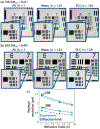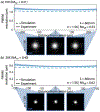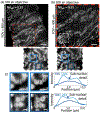Solid immersion meniscus lens (SIMlens) for open-top light-sheet microscopy
- PMID: 31517904
- PMCID: PMC7331451
- DOI: 10.1364/OL.44.004451
Solid immersion meniscus lens (SIMlens) for open-top light-sheet microscopy
Abstract
Open-top light-sheet (OTLS) microscopy has been developed for rapid volumetric imaging of large pathology specimens. A challenge with OTLS microscopy is the transmission of oblique illumination and detection beams through a horizontal sample plate without introducing aberrations. Previous solutions prevented vertical sample movement, constrained the refractive index of the sample, and/or hindered multi-resolution imaging. Here we describe a solid immersion meniscus lens, a wavefront-matching element that suppresses aberrations when illumination and detection beam transition between air and various high-index immersion media, thereby enabling multi-resolution OTLS microscopy of specimens cleared with diverse protocols.
Figures






References
Grants and funding
LinkOut - more resources
Full Text Sources
Other Literature Sources

